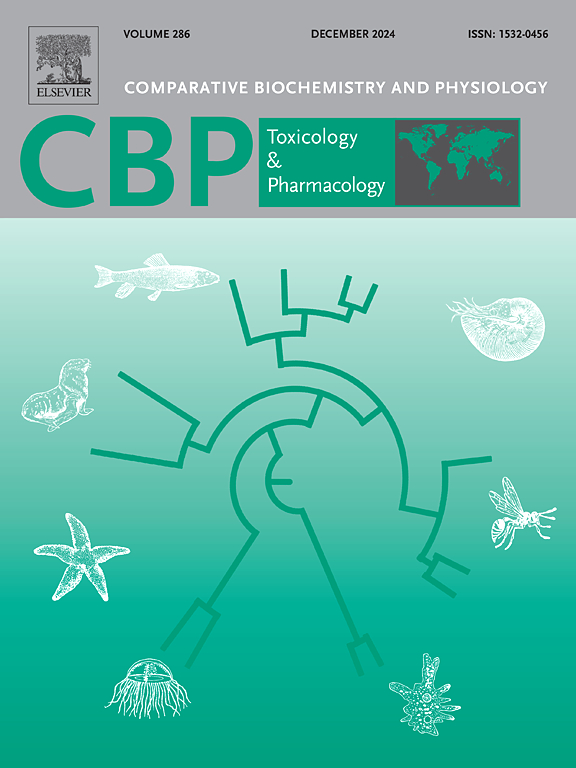Acute hypoxia induces sleep disorders via sima/HIF-1α regulation of circadian rhythms in adult Drosophila
IF 3.9
3区 环境科学与生态学
Q2 BIOCHEMISTRY & MOLECULAR BIOLOGY
Comparative Biochemistry and Physiology C-toxicology & Pharmacology
Pub Date : 2025-03-12
DOI:10.1016/j.cbpc.2025.110192
引用次数: 0
Abstract
The atmospheric oxygen concentration is significantly reduced in highland regions compared to lowland areas. The first entering the plateau can induce sleep disorders in individuals, primarily attributed to insufficient oxygen supply. This study used Drosophila melanogaster as a model organism to better understand the molecular mechanism of acute hypoxia-induced sleep disorders. The Drosophila activity monitoring system (DAMS) was employed to observe the sleep-wake in adult (w1118, simaKG07607, and clockjrk) female flies. Quantifying the relative mRNA expression levels of sima and circadian clock genes in the head of flies was accomplished by utilizing qRT-PCR. Acute hypoxia caused sleep disorders in w1118 flies, such as shortened sleep duration and length, and prolonged sleep latency. PCR results showed that sima and clock genes were up-regulated in ZT6 and ZT12 and down-regulated in ZT0 and ZT18 in acute hypoxic w1118 flies compared to normoxic w1118 flies. Under normoxic conditions, sleep indexes in simaKG07607 flies were not substantially different from w1118 flies. However, clockjrk flies demonstrated a reduced sleep duration, decreased sleep bout length, and increased sleep latency and activities. Sleep and gene expression in simaKG07607 flies under acute hypoxic conditions were not significantly different from those under normoxic conditions. Surprisingly, sleep and gene expression in clockjrk flies showed opposite trends to w1118 flies. The present study indicates that acute hypoxia disrupt circadian rhythms through the activation of sima/HIF-1α, leading to the onset of sleep disorders, with Clock signaling potentially serving as a contributing factor.

急性缺氧通过sima/HIF-1α调节成年果蝇昼夜节律诱导睡眠障碍
高原地区的大气氧浓度明显低于低地地区。第一次进入高原可引起个体睡眠障碍,主要是由于氧气供应不足。本研究以黑腹果蝇为模型生物,更好地了解急性缺氧诱导睡眠障碍的分子机制。采用果蝇活动监测系统(DAMS)对成年雌性果蝇(w1118、simaKG07607和clockjrk)进行睡眠-觉醒观察。利用qRT-PCR技术定量测定蝇头sima和生物钟基因mRNA的相对表达水平。急性缺氧导致w1118果蝇的睡眠障碍,如睡眠持续时间和长度缩短,睡眠潜伏期延长。PCR结果显示,与正常缺氧的w1118相比,急性缺氧的w1118中sima和clock基因在ZT6和ZT12中表达上调,在ZT0和ZT18中表达下调。在常压条件下,simaKG07607果蝇的睡眠指标与w1118果蝇没有显著差异。然而,生物钟紊乱的果蝇表现出睡眠持续时间缩短,睡眠时间缩短,睡眠潜伏期和活动增加。急性缺氧条件下的simaKG07607果蝇的睡眠和基因表达与正常缺氧条件下的果蝇没有显著差异。令人惊讶的是,生物钟果蝇的睡眠和基因表达与w1118果蝇的趋势相反。目前的研究表明,急性缺氧通过激活sima/HIF-1α破坏昼夜节律,导致睡眠障碍的发生,时钟信号可能是一个促成因素。
本文章由计算机程序翻译,如有差异,请以英文原文为准。
求助全文
约1分钟内获得全文
求助全文
来源期刊
CiteScore
7.50
自引率
5.10%
发文量
206
审稿时长
30 days
期刊介绍:
Part C: Toxicology and Pharmacology. This journal is concerned with chemical and drug action at different levels of organization, biotransformation of xenobiotics, mechanisms of toxicity, including reactive oxygen species and carcinogenesis, endocrine disruptors, natural products chemistry, and signal transduction with a molecular approach to these fields.

 求助内容:
求助内容: 应助结果提醒方式:
应助结果提醒方式:


